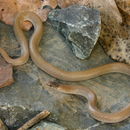en
names in breadcrumbs


Tantilla hobartsmithi, commonly known as the southwestern blackhead snake, Smith's blackhead snake, or Smith's black-headed snake, is a species of small colubrid snake native to the southwestern United States and northern Mexico.
The specific name or epithet, hobartsmithi, is in honor of American zoologist and herpetologist Hobart M. Smith (1912–2013).[3]
T. hobartsmithi was first described by Edward Harrison Taylor in 1936.
The southwestern blackhead snake is a small snake, growing to a maximum total length (including tail) of 15 in (38 cm), but typically averaging around 8 in (20 cm) in total length.
Dorsally, it is uniformly brown in color, except for the black-colored head, which gives it its common name, and a cream-colored or white collar. On the belly, there is a broad reddish stripe, which runs down the center of the ventral scales.[4]
T. hobartsmithi is rear-fanged, having enlarged rear teeth and a modified saliva, which while harmless to mammals, is believed to be toxic to arthropods, its primary prey.
Blackhead snakes (genus Tantilla) are primarily nocturnal and fossorial, spending most of their time hiding in loose soil, leaf litter, or under ground debris.
Blackhead snakes eat most varieties of soft-bodied insects and centipedes.
T. hobartsmithi is oviparous.[5]
The southwestern blackhead snake is found in the southwestern United States, in Arizona, California, Colorado, Nevada, New Mexico, Texas, and Utah, as well as in northern Mexico, in Chihuahua, and Coahuila, and Sonora.[6]
The preferred natural habitats of T. hobartsmithi are desert, grassland, shrubland, and forest.[1]
Tantilla hobartsmithi, commonly known as the southwestern blackhead snake, Smith's blackhead snake, or Smith's black-headed snake, is a species of small colubrid snake native to the southwestern United States and northern Mexico.